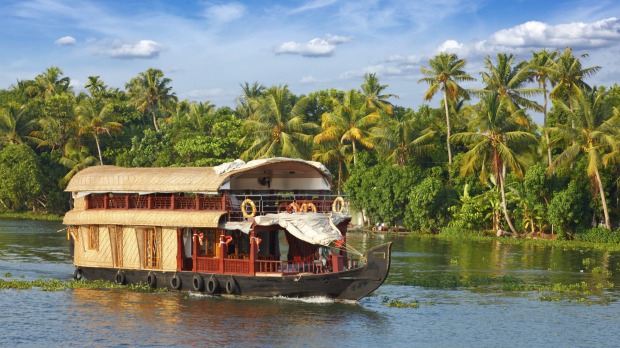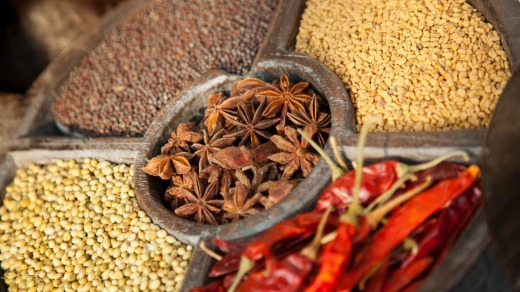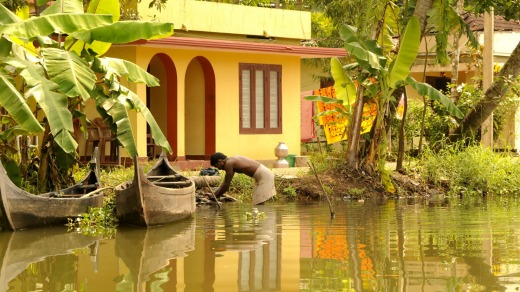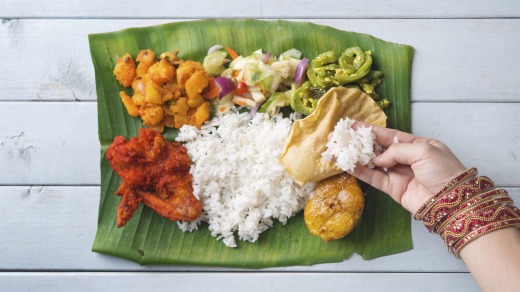
Drifting through the Kerala backwaters we slide through a blush of hyacinths, their pink petals clutching at our small boat like dainty fingers. Escaping their grip we continue along the Kavanar River, one of the silver threads making up the web of rivers and lakes that run parallel to the Arabian Sea in south-western India. This is the fructiferous world depicted by Arundhati Roy in her Booker Prize-winning novel, The God of Small Things.
"May in Ayemenem is a hot brooding month," Roy writes. "The river shrinks and black crows gorge on bright mangoes in still, dust green trees. Red bananas ripen. Jackfruits burst. Dissolute bluebottles hum vacuously in the fruity air. Then they stun themselves against clear windowpanes and die, fatly baffled in the sun."
Today, this same plump sun warms us as we slide beneath nodding palm trees, passing mango and coconut plantations and little boxy houses so vibrant they look like they've drawn by children. Fishermen in dug out canoes wave, while around us bejeweled kingfishers divebomb the water, emerging grinning with a slash of silver squirming in their beaks. But all this loveliness is just a taste of the feast that awaits; a cooking demonstration at Philipkutty's riverside farm.

The farm, which can be reached only by boat, is located on a green jellybean of an island in the backwaters by Vembanad Lake. As part of Insider Journey's 14-day Spice of the South tour, a cooking demonstration is the perfect introduction to southern Indian cooking, which is lighter and fresher than other parts of India.
We are met at the jetty by Anu Mathew and her mother-in-law Aniamma, known to all as "Mummy". Wrapped in a froth of tangerine, lime green and lavender fabric these two striking women appear to have blossomed straight out of the farm's very own fruit orchard.
Surrounded by such a rich bounty, I can't help but wonder how I stopped focusing on fresh foods and started looking for quick and easy options.
After a welcome drink of lime and ginger we are led inside for the demonstration, where, instead of finding a purpose-built facility we are invited into the family's own kitchen, the hub of their home. "We want people to feel relaxed," says Anu. "Like they are at a friend's house." I'm happy to learn that this isn't a serious cooking class, more an informal demonstration with the promise of much feasting afterwards.

Like many in the area Anu and her family are Syrian Christian, a community of Christians who trace their origins to Thomas the Apostle, who landed along this coast in 52AD. While Anu talks, Mummy starts the first dish, cabbage thoren, a vegetable dish traditionally served at lunch. The toasty smell of frying mustard seeds fills the air as Mummy swirls the shrieking seeds in a large, heavy-based frying pan. We learn that his technique is called katuku-varakkal (mustard seed frying), and is often the first step in making many of Kerala's famous curries. "Getting the salt right is the second," says Anu. "It must be in harmony with the chilli, the sweet and the sour."
Mummy selects her spices – nutmeg, pepper, cloves, and cardamom – from a traditional timber spice wheel, adding a pinch here and there to the sizzling onion, cabbage, curry leaves and freshly grated coconut. The word Kerala comes from Kera, the local word for coconut, which can be found grated, ground or slivered in every dish along Kerala's 590-kilometre, palm-fringed coastline.
Gathered in Anu's homely kitchen, with a soft, fragrant breeze fanning through the open doors, I'm happy to sit and watch. Ordinarily, I love food and I love cooking; but today is more about immersion in a local culture than any MasterChef aspiration I may have.

As Mummy starts on the second dish, a prawn masala, Anu explains the ingredients and the health benefits of each – turmeric to ward off infection, ginger to lower cholesterol, cumin to aid digestion. These are followed by shallots, green chilli, garlic and curry leaves, all bruised and battered to release their aromas, before the locally-caught prawns are added to the pan.
Surrounded by such a rich bounty, I can't help but wonder how I stopped focusing on fresh foods and started looking for quick and easy options. "Most of our foods are either grown or raised on the farm or pulled fresh from the waters," says Anu. "If we don't grow it, the river out front is our floating supermarket." Immediately my own sterile supermarket pales in comparison.
We leave Mummy to continue with her cooking – fish moilee, duck curry and coconut mil soufflé – while Anu shows us around her garden. Since the loss of their husbands, these two entrepreneurial women have continued to run the sustainable farm, homestay and cooking classes on their own. "By working together we hope to fulfil the dreams of these two much-loved men," says Anu.

While it may be unusual in other rural parts of India for women to be so enterprising, in Kerala it is common. Thanks in part to the now outdated Malayalam custom of marumakkathayam (where property was traced through females) this southern state has long been known for its more equal treatment of women. The modern state of Kerala now boasts the country's highest female literacy rate (almost 100 per cent) as well as a population of 1080 women to every 1000 men, rare statistics in a male-dominated country.
Anu shows us the six waterfront villas they have built, with plans on the drawing board for more, their thriving coconut plantations, herb garden, free-ranging chickens and rare Keralan Vechur cows, from which they make yoghurt. This dynamic duo shares their fortune with local villagers, by providing free land or grass for cows, free fuel and much needed employment.
Back at the main house a banquet is laid out under an adjacent open-air pavilion; I count a total of ten steaming dishes, each supported by a platoon of banana chips, crunchy poppadoms, pungent pickles and nutty rice. In true Kerala form we are introduced to the final step in local cuisine – eating with our bare fingers. "Each of the fingers is an extension of the five basic elements of nature – fire, air, space, earth and water," explains Anu. "So eating with bare hands allows you to connect with the food and the universe as a whole." While I've struggled to date, my tray or banana leaf ending up looking like a mini-cyclone has passed through, under Anu's tutorage I finally master the technique, using four fingers to roll the food into a ball and finally flicking it into my mouth with my thumb. "Just like flicking a pinball flipper," remarks one of the guests.
1 Fish moilee a light and delicate dish of fish cooked in coconut milk and spices. Best served with Appam (rice pancake).
2 Sadya a banquet of vegetarian dishes traditionally served on a banana leaf.
3 Nadam mutta basically an egg curry with coconut milk served at breakfast.
4 Nadam tharavu a spicy and tangy duck curry in coconut gravy.
5 Coconut soufflé a sweet dessert pudding of tender coconut and condensed milk, garnished with almonds.
insiderjourneys.com.au
Singapore Airlines operates regular flights from Sydney and Melbourne, via Singapore, to Bangalore and other departure points for Insider Journeys tours see singaporeairlines.com. Australians need a visa for tourism for up to six months.
The 14-day day Spice of the South Small Group Journeys run from September 2015 to March 2016. With a maximum of 16 passengers, the tour starts in Bangalore, and includes Mysore, Nagarhole National Park, Coonoor, Ooty, Munnar, and the Kerala backwaters before finishing in Cochin. Starting from $4675 per person twin share, excluding airfares. See insiderjourneys.com.au
The writer was a guest of Insider Journeys (formally Travel Indochina)